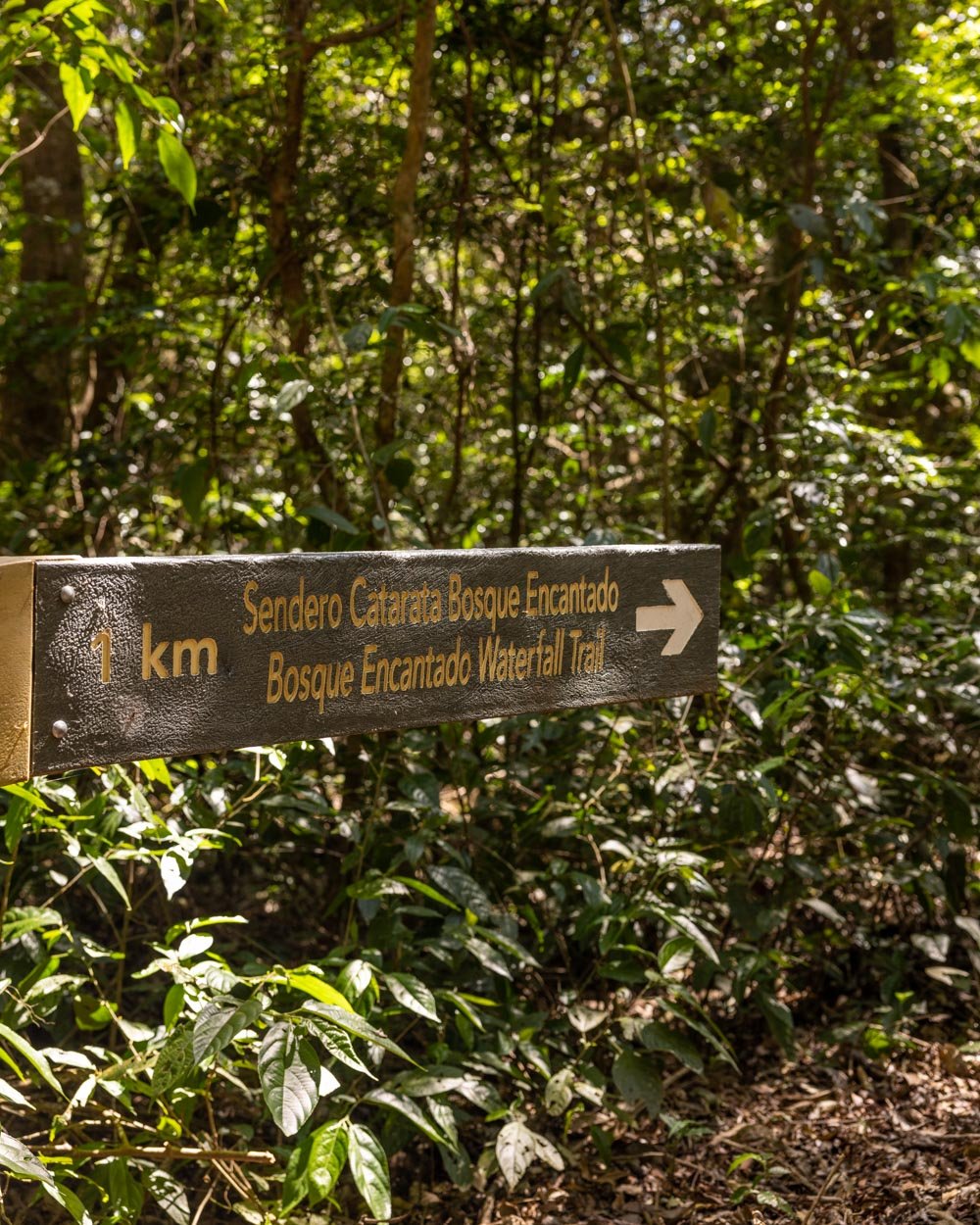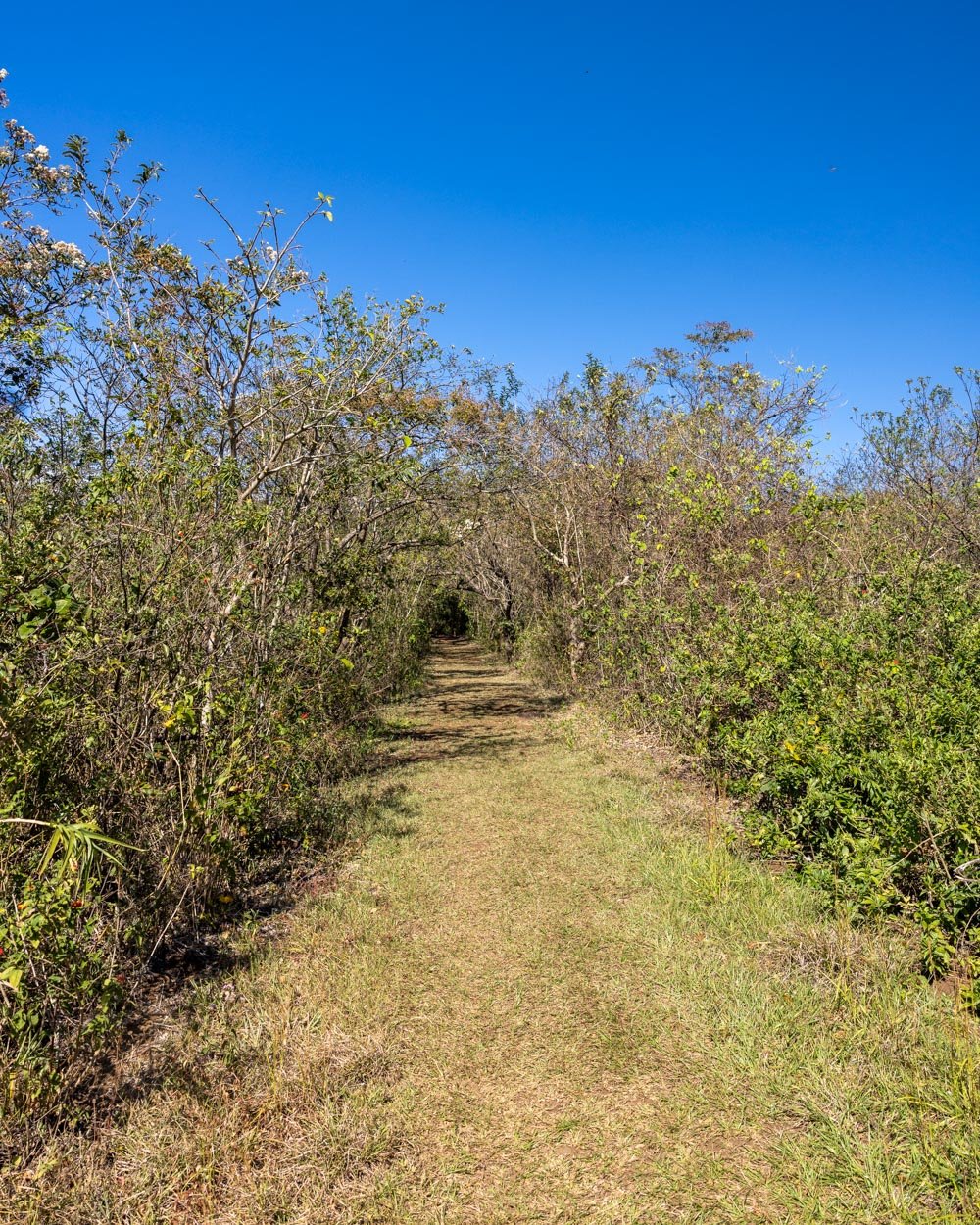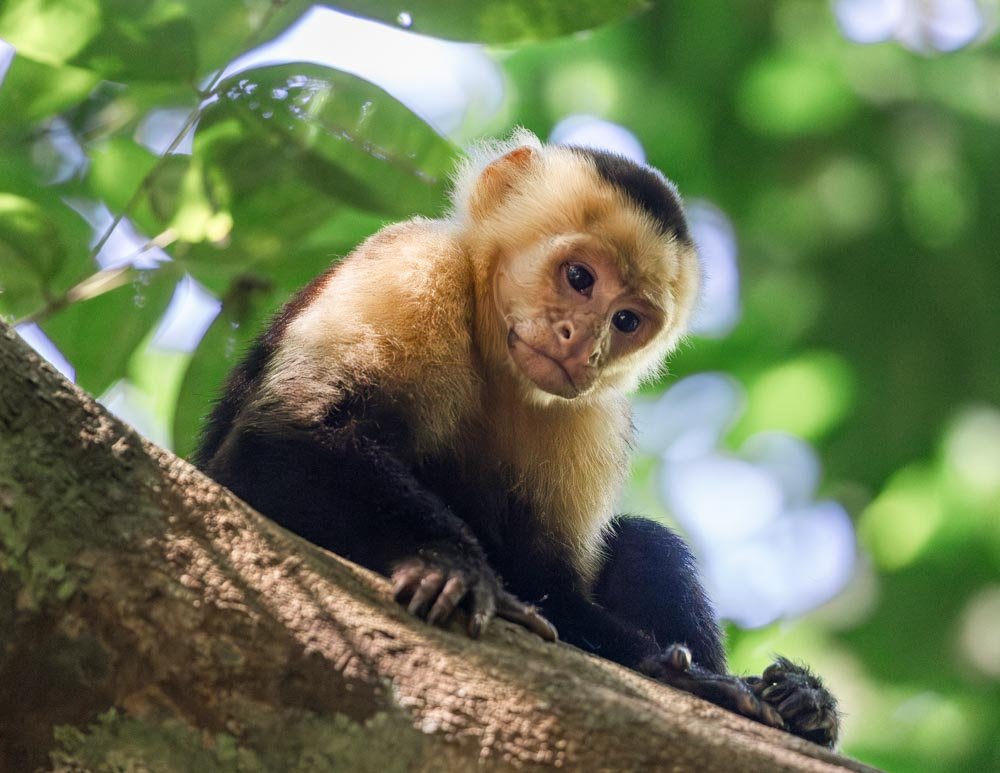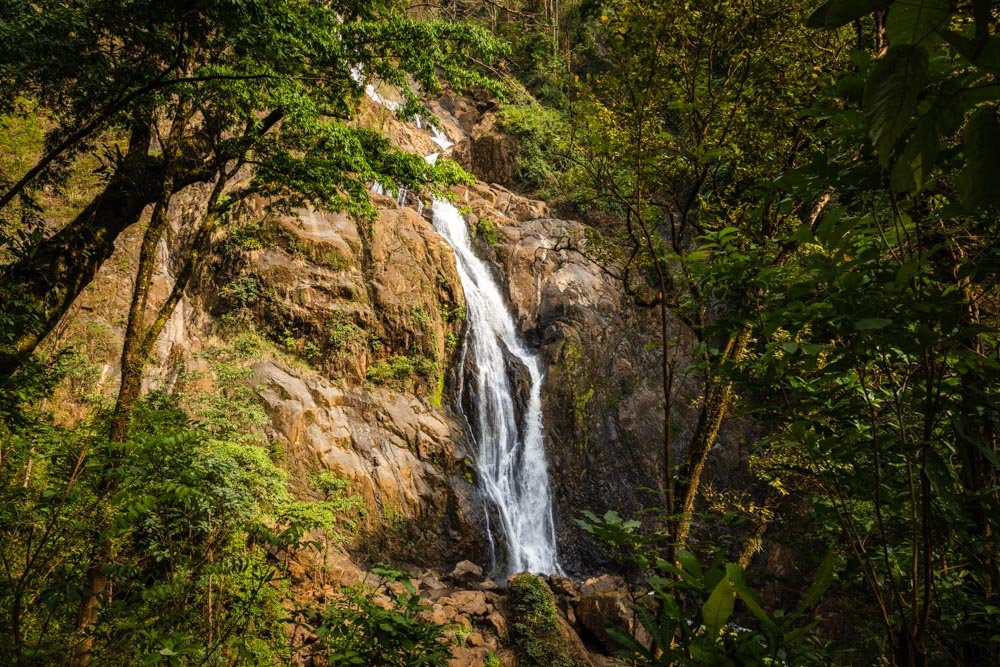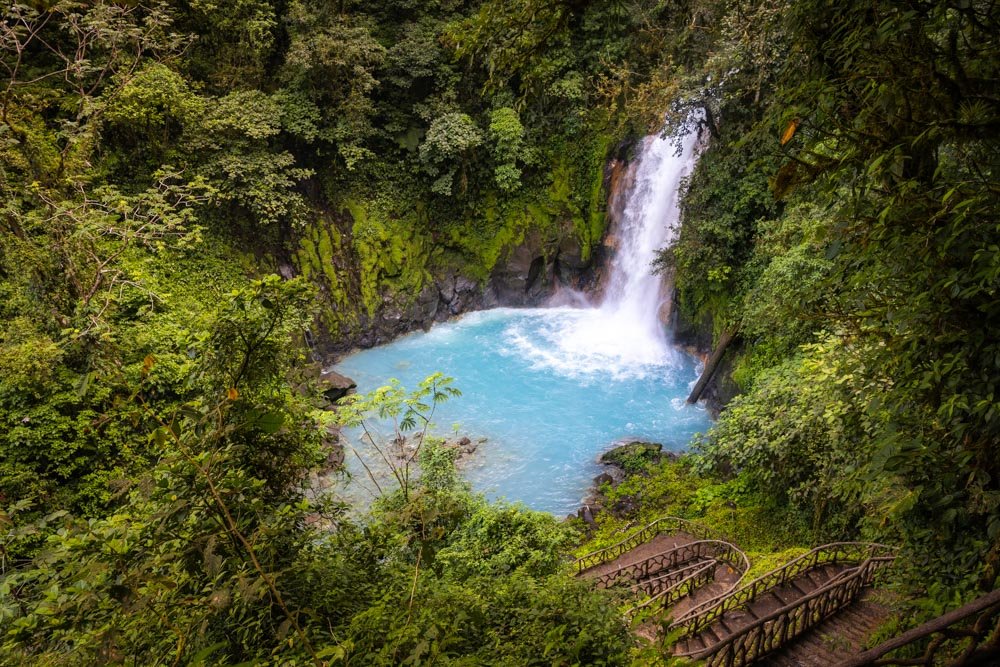The Santa Maria Sector in Rincon de la Vieja National Park must be one of the most underrated gems in Costa Rica. Most people head to the other side of the park, where you’ll find La Cangreja Waterfall and the bubbling mud pools, leaving the Santa Maria Sector blissfully quiet.
We took the Senderos Aguas Termales route which leads to two forest waterfalls you can swim in, before finishing at the incredible hot springs. The waterfalls are nice, but it’s the hot springs that really blew me away. They are the real deal. Beautiful blue pools properly out in nature, not a slab of concrete or artificial staircase in sight.
Soaking here was one of my most memorable moments in Costa Rica, and trust me, it’s a hard spot to leave. Edit for 2024: sadly you are no longer allowed to bathe in the hot springs, however you can still visit.
Here’s everything you need to know about visiting the hot springs at the Santa Maria Sector of Rincon de la Vieja National Park.
The Santa Maria Sector hot springs walk
The stats
Distance: 6.4km return (including all side trails to the waterfalls)
Elevation gain: 200m
Difficulty: Easy to moderate
The walk to get to the hot springs is not difficult in the dry season. There are a few river crossings, but all are very easy during times of low rainfall, and you don’t need to get your boots wet. In the rainy season, it’s a different story and these crossings are trickier - though there are wires in place to help you.
Aside from the river crossings, the path is mainly a good dirt track. In the dry season there is very little mud, but again, in the rainy season it would be a lot muddier.
The track does have a few climbs, but it’s rarely steep. The majority of the walk is in the shady forest.
Starting the trail to the Enchanted Forest Waterfall (Bosque Encantado)
From the ranger station where you buy your tickets, the walk crosses the grassy area and passes the toilet and campsite. From here it’s signposted and the signs continue throughout the trail.
The dirt track heads briefly downhill before it flattens and you’ll come to your first river crossing after 400m. For us in the dry season, this was a little stream and there were plenty of rocks to use as stepping stones.
You’ll continue on straight, following signs for the hot springs. There’s another little creek crossing at the 550m mark, but there’s a wooden plank to get your over easily.
After another 450m along the dirt track through the forest you’ll see a sign for the first waterfall on the left, the Enchanted Forest Waterfall (Bosque Encantado).
The falls are 150m away. The path is mainly downhill and has a few rocks and tree roots, but it’s an easy enough detour.
The waterfall is pretty, more like a set of cascades than a substantial waterfall in the dry season. There is a little water hole which you can take a dip in, but the pool at the next waterfall along is a lot better for swimming.
I’d say this one is more about sitting on one of the big rocks and relaxing before moving on to waterfall number two.
Continuing on to Morpho Waterfall (Catarata Morpho)
Once you’re back on the main trail again, it’s just 100m before you reach river crossing number two. This one is bigger and would be more significant in the rainy season.
There is a long wire line beside the big boulders which gives you added stability. For us the water was very shallow and crossing was just a case of using the rocks as stepping stones. Just watch out for the first set of rocks which wobble significantly.
On the return walk I wobbled right off one, which wasn’t a problem with the shallow water, but it did mean I finished the trail with wet boots!
Immediately after the river crossing, you’ll see a sign on the left for Morpho Waterfall (Catarata Morpho).
This one is a 350m detour and it’s mainly downhill. It’s steeper than the track to the Enchanted Forest Falls, but it’s quite quick getting down. It’s a dirt track that’s in good condition when it’s dry.
The final few metres down to the falls are a bit rougher and there’s a wire in place to use for stability if needed.
Swimming at Morpho Waterfall
By Costa Rican standards, Catarata Morpho is a modest size, but it’s still a lovely little spot. The pool has crystal clear water and it gets quite deep as you near the waterfall.
Getting in requires climbing over one log and then a couple of rocks, but once inside the water it was smooth sailing, and a gorgeous place for a quick dip. We even got some little rainbows in the spray.
The walls surrounding the falls keep at least part of the pool shady, which is perfect as this part of Costa Rica gets super hot.
I swam on the way to the hot springs, but it might be nice to do it on the way back, so you cool off after the springs.
Continuing on to the hot springs (Aguas Termales)
Once you’re back up on the main trail, you have just over 1.6km until you reach the hot springs. It’s almost all through the forest and is mainly downhill.
I didn’t really notice much was downhill until the return leg. It’s pretty gentle, and there’s just one final river crossing.
This is 550m from the Morpho Waterfall turnoff and is another bigger one - although it’s a non-event in the dry season. There is a wire running across it again, but in the dry season there was barely any water and the rocks were stable, so it was even easier than the previous river crossing.
Roughly 100m after crossing the river you’ll come to a junction and the hot springs are signposted. The track gets a little steeper through the forest, but nothing challenging, and you may not even notice on the way down.
There is one short patch of track where you leave the forest and it’s more open, but it doesn’t last long, so you pretty much have shade the entire way.
You’ll arrive at the hot springs after you’ve been walking for 3.7km (from the ranger station). The return route is slightly shorter, as you don’t make the detours to the waterfalls.
The hot springs
I didn’t know what to expect from the hot springs and I couldn’t believe how lovely they are. There are two main pools nestled beneath the cliffs right next to a running stream.
The beauty of having the river beside the pools is that you can alternate between the springs and the cold water when you need to cool off.
The temperature of the springs is not super hot, and it’s relatively shallow, so it’s actually perfect for the Costa Rican climate.
As we were walking to the springs, I imagined I’d only be able to stay in for 10 minutes or so as it was such a hot day, but happily the pools were in the shade and I could stay in as long as I liked.
The best time to visit would be early morning or later in the afternoon, or the pools would be in the sun, and I don’t think that would be so enjoyable. Alternatively a cloudy day would be ideal as then you could go anytime.
The setting of the springs is stunning and the water colour is a milky blue. In the pool on the right you can even see the spring itself bubbling away, which was really cool.
It’s a magical little spot and my only wish is that we’d had longer here - we only had around 45 minutes before we had to begin the return walk, and I could have stayed double that time and more.
The only thing to watch out for which could mar your experience is ticks. Not by the hot spring itself, but by the rocks near the end of the trail, by the cool stream (the area you will likely get changed). I got two ticks which luckily I spotted straight away, so they were easy to flick off.
Be vigilant by the rocks, or come with your swim suit already on so you can get into the pools straight away (it wasn’t buggy at all in, or right beside the pools).
When you’re ready to tear yourself away, the return walk does have more uphill than the way in, but after the first half it gets a lot flatter. It only took us around 35 minutes to walk back.
Know before you go
Facilities at the Santa Maria Sector of Rincon de la Vieja National Park
There are flush toilets with toilet paper and soap, but very little else in the way of facilities. There were some nice little camping platforms, but sadly camping in the park is currently closed.
The access road
To reach the Santa Maria ranger station you will need to drive along a gravel road. Coming from Liberia, the last 25-30 minutes of the journey were on a mix of gravel road and paved bits (the paved sections tended to be any hills that would have required a 4WD if they weren’t paved).
The last 2.5km are narrow and a bit rocky. In the dry season you don’t need a 4WD, but it’s very bumpy. In the rainy season you may require a 4WD, but it’s hard to say as we’ve only seen it dry. In any season you will be more comfortable if your car has a bit of clearance, but you won’t need a proper 4WD.
From Liberia the journey took around 50 minutes.
To the other side of the park, the Pailas Sector, it’s a 25 minute drive and I believe will have less gravel road (though both routes have some gravel sections).
Santa Maria Sector opening hours and entry fees
This side of the park is only open Thursday to Sunday at time of writing. The park is technically open from 8am to 3.30pm. However, when I asked about the close time I was told the closing time was 4.30pm and that there was even a little flexibility with that.
For adult foreigners the entry fee is USD $16.95. For foreign children it’s USD $5.95. Adult nationals and residents pay 1130 colones (just over USD $2) and children pay 565 colones (just over USD $1).
A limited number of people per day are allowed to enter the park. It was very quiet on our visit (on a weekday) but it might be worth reserving tickets anyway. We booked on this website and then you pay when you get there (you don’t pay extra to do this).
Only credit cards are accepted, no cash.
This post may contain affiliate links, meaning at no additional cost to you, we will earn a small commission if you click through and decide to make a purchase. This helps towards the costs of running our website. Thanks for your support.






